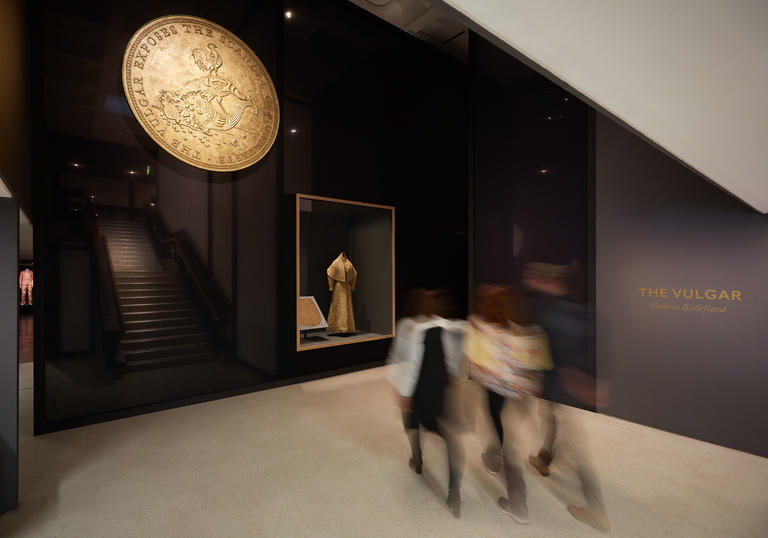What drew you to the word ‘vulgar’ as the starting point for this exhibition?
‘We noticed that the way in which people used the word vulgar exposed assumptions about tastefulness. It was the certainty with which they used the word – and the ambiguity of the word itself – that made it so compelling, in both the language of clothes and that of psychoanalysis.’
You both come from different specialisms, Judith from curating fashion exhibitions and Adam from psychoanalysis. How do you collaborate on your projects?
‘We are both interested in putting the two languages together, without assuming that either one is privileged. The word ‘vulgar’ combines an interest in the unacceptable with a question of perspective through construction and description. The process begins with the new definitions, which prompt associations and inform the selection both of the objects and the installations.’
You previously worked together on an Artangel commission, The Concise Dictionary of Dress, in the V&A’s reserve collection store at Blythe House. Your projects commonly explore the way we define ourselves through our clothing and how clothing represents us. Can you talk about the process of creating and using definitions for this exhibition?
‘Definitions – in this case about the vulgar – like clothes, are about self-fashioning. The variety of definitions used in the exhibition reveal the instability of the meanings attached to vulgarity. Fashion, like language, is constantly evolving. Excess, extravagance, exhibitionism are all ideas that are constantly revised.’
The exhibition has an incredible range of garments and ‘looks’ in terms of time period. It spans 500 years and the selection of designers includes an array of well known contemporary names. Some of the looks seem incredibly beautiful and tasteful. Can you explain what it is that makes something apparently vulgar?
‘The exhibition’s thesis is that nothing is intrinsically vulgar; vulgarity is the consequence of description. The exhibition intentionally resists ascribing vulgarity, but starts from the assumption that we know vulgarity when we see it. It is, however, surprisingly diverse in its references when you look at the use of the word over time: the common or the popular, the vernacular, or associated with imitation – all are included in fashion.’
What can we expect to see in the exhibition?
‘The exhibition is mostly about recent fashion, including pieces as current as Autumn/Winter 2016. It also draws on iconic dress from different periods to make specific thematic and conceptual points; the 18th century’s relationship to excess is a recurring theme, so we have included both original exquisite mantuas from the Fashion Museum at Bath with their imposing silhouette, as well as more recent interpretations of their extravagance.
The installations are accompanied by suggestive descriptions of the uses and abuses of the word. The Vulgar includes pieces that were controversial and therefore much discussed at the time of their appearance such as the YSL Mondrian dress which unsettled the classification of art and fashion; Maison Martin Margiela’s photocopy dress ‘exhibiting’ the production line of ideas; and Galliano’s looks for Dior from the turn of this century, re-imagining fashion as historical drama.’
Judith, you originally studied architecture and moved into curating fashion. You work on your projects in a very particular way, both curating the objects and designing the exhibition space. Can you talk about the relationship between the objects and the design, and how this process works?
‘My work is about both the object and exhibition-making (the plinth, the mannequin, the wig, the gesture, the route). This project is important to me as it incorporates the notion that fashion exhibitions themselves have been considered vulgar – particularly in the museum – because of their association with commerce, and with the ‘blockbuster’ associating popularity with vulgarity. So my design for this project includes the idea of aspiration, both in terms of the fashioning of an individual and that of the classification of an object.’

